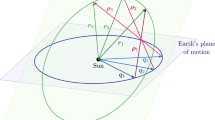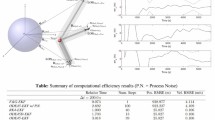Abstract
A novel approach for initial orbit determination based on multiple angles-only observations is presented. The proposed technique is iterative and uses Lagrangian coefficients, f and g. The proposed method does not show singularity for the coplanar cases. In addition, the method is capable of handling multiple observations, providing higher accuracy, whereas the level of the algorithm complexity and processor running time remain almost invariant. The technique presented is compared with the Double r-iteration and Gauss’ methods using data corrupted by noise to simulate true measurements. Results show that the proposed method is a valid alternative to the classical methods of orbit determination.
Similar content being viewed by others
References
Anderson, J.D.: Theory of orbit determination. Part I: classical methods. Jet Propulsion Laboratory Technical Report, No. 32–497, Prepared Under Contract No. NAS7-100, NASA (1963)
Branham R.L.: Laplace orbit determination and differential corrections. Celest. Mech. Dyn. Astron. 93, 53–68 (2005)
Celletti A, Pinzari G.: Dependence on the observational time intervals and domain of convergence of orbital determination methods. Celest. Mech. Dyn. Astron. 95, 327–344 (2006)
Curtis H.D.: Orbital Mechanics for Engineering Students. Elsevier Butterworth-Heinemann, Amsterdam/Boston (2005)
Escobal P.R.: Methods of Orbit Determination. John Wiley and Sons, Inc., New York (1965)
Gooding R.H.: A new procedure for the solution of the classical problem of minimal orbit determination from three lines of sight. Celest. Mech. Dyn. Astron. 66(4), 387–423 (1997)
Herget, P.: The Computation of Orbits. Edwards Brothers Inc., Ann Arbor, published privately by the author (1948)
Kristensen L.K.: Single lunation N-observation orbits. Celest. Mech. Dyn. Astron. 105(4), 275–287 (2009)
Laplace, P.S.: Mémoires de l’Académie Royale des Sciences. Paris, Reprinted in Laplace’s Collected Works 10(93), 1780
Turner J.D.: Automated generation of high-order partial derivative models. AIAA J. 41(8), 1590–1598 (2003)
Vallado, D.A.: Fundamentals of Astrodynamics and Applications. Microcosm Press, El Segundo, CA, Academic Publishers Dordrecht/Boston/Kluwer (2001)
Author information
Authors and Affiliations
Corresponding author
Rights and permissions
About this article
Cite this article
Karimi, R.R., Mortari, D. Initial orbit determination using multiple observations. Celest Mech Dyn Astr 109, 167–180 (2011). https://doi.org/10.1007/s10569-010-9321-3
Received:
Revised:
Accepted:
Published:
Issue Date:
DOI: https://doi.org/10.1007/s10569-010-9321-3




